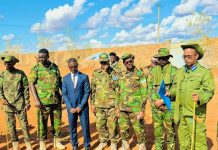
The United States conducted its first drone strike in Somalia since August on Feb. 22, according to AFRICOM. This strike was conducted in coordination with the Federal Government of Somalia (FGS) against Al Shabaab insurgents in Duduble, 40 miles northwest of Mogadishu.
The strike came one week after Shabaab, Al Qaeda’s affiliate in East Africa, conducted a series of suicide bombings in Mogadishu in an attempt to disrupt ongoing parliamentary elections. The terrorist group has increased its number of attacks recently in a bid to delegitimize the FGS and undermine its support from the international community, especially the African Union. The FGS has struggled to curb the insurgency, as it controls and governs territory in five of Somalia’s six federal states, Puntland being the lone exception.
Shabaab has been particularly effective in southwest Somalia and has leaked into northeastern Kenya, where it also operates bases. As a result of the group’s territorial control, Shabaab is one of Al Qaeda’s most successful branches and hopes to follow the Taliban model in Afghanistan to take over the country once international support for the FGS wanes.
While this is the first U.S. strike against Shabaab in seven months, the African Union (AU) has played an integral role in bolstering Somali security and inhibiting the spread of Shabaab through its mission in Somalia, AMISOM.
Last month, the AU and FGS reached an agreement to extend AMISOM, whose mandate was scheduled to expire on March 31, 2022. The extension also entailed a shift in mission to prioritize transitioning security responsibility to Somali institutions with increased focus on training and developing forces under a new title, the AU Transition Mission in Somalia or ATMIS.
Currently, AMISOM has 22,000 troops in Somalia and has been instrumental in preventing further conquest by Shabaab. While the mission has largely curbed the advances of the jihadist insurgents, it has had limited success in recapturing territory, uprooting militant cells, or sustaining operational momentum due to budgetary constraints.
Assessments by both U.S. forces and Somali troops on the ground determined that no civilians were injured or killed in last week’s strike, while AFRICOM stated that 3 Shabaab militants were killed. In addition to the airstrike in Duduble Hiran, the Somali National Army (SNA) conducted assaults against Shabaab bases in Middle Shabelle using their U.S.-trained commandos known as “Danab.”
SNA Chief General Odowaa Yusuf Rageh claimed that the airstrike and accompanying attacks killed 60 Shabaab militants while destroying their main tax office. Military leaders also claimed that five top Shabaab leaders were killed in the strike, though no names have been released. These figures have not been confirmed by any independent sources; however, the large-scale attack against Shabaab is the latest in a recent series of offensives conducted by the SNA as it attempts to resurge and prove it can defend its territory without external assistance. Though individual operations such as last Tuesday’s have been successful in degrading Shabaab’s armed forces and bases, the SNA does not have the capacity to hold villages after clearance operations, which allows the militants to return.
This U.S. airstrike falls under collective self-defense authority, according to AFRICOM, in support of partner forces.
In Dec. 2020, the Trump administration withdrew almost all of the 700 American troops stationed in Somalia on advise and assist missions, so no U.S. forces were on the ground accompanying the Somali National Army (SNA). However, the U.S. forces were relocated to Djibouti and Kenya, where they have continued to send small numbers of advisors to train the Danab Special Forces in Somalia.
It remains to be seen whether this attack will signify an increased American focus on the ongoing insurgency in Somalia, or if it is merely a one-off strike to relieve pressure on a beleaguered Somali military. Airstrikes like this to support ground assaults by local forces will likely be a staple of the Biden administration’s over-the-horizon counterterrorism doctrine, though more is certainly needed to effectively reduce the threat posed by Shabaab in Somalia and northeastern Kenya.
Ongoing political instability, the transitioning AU mission in Somalia, and a Shabaab emboldened by the Taliban’s success in Afghanistan pose a particularly tough challenge for the FGS, but continued assistance from AFRICOM should help lighten their burden.











